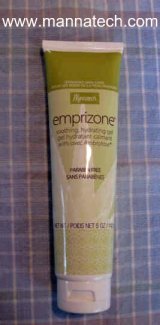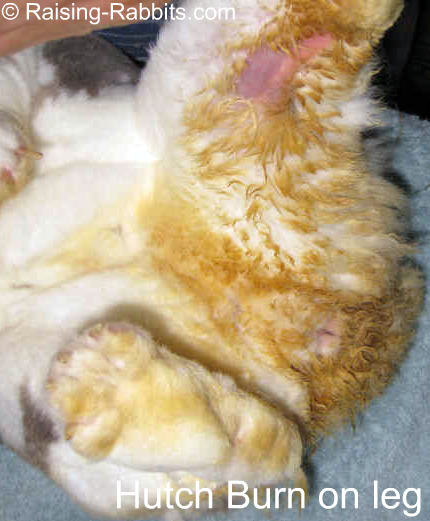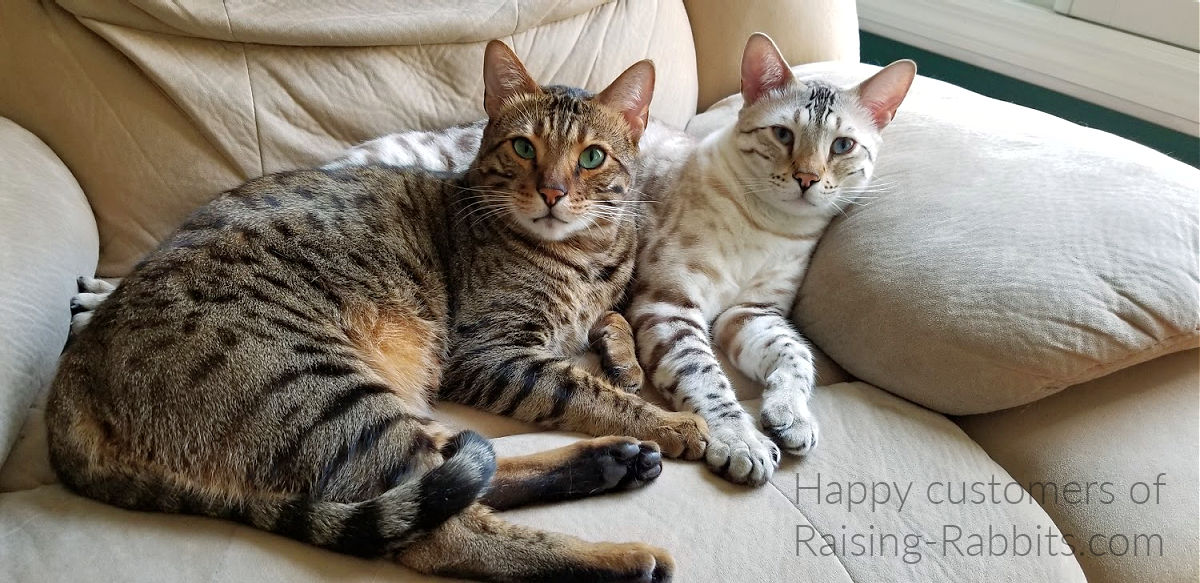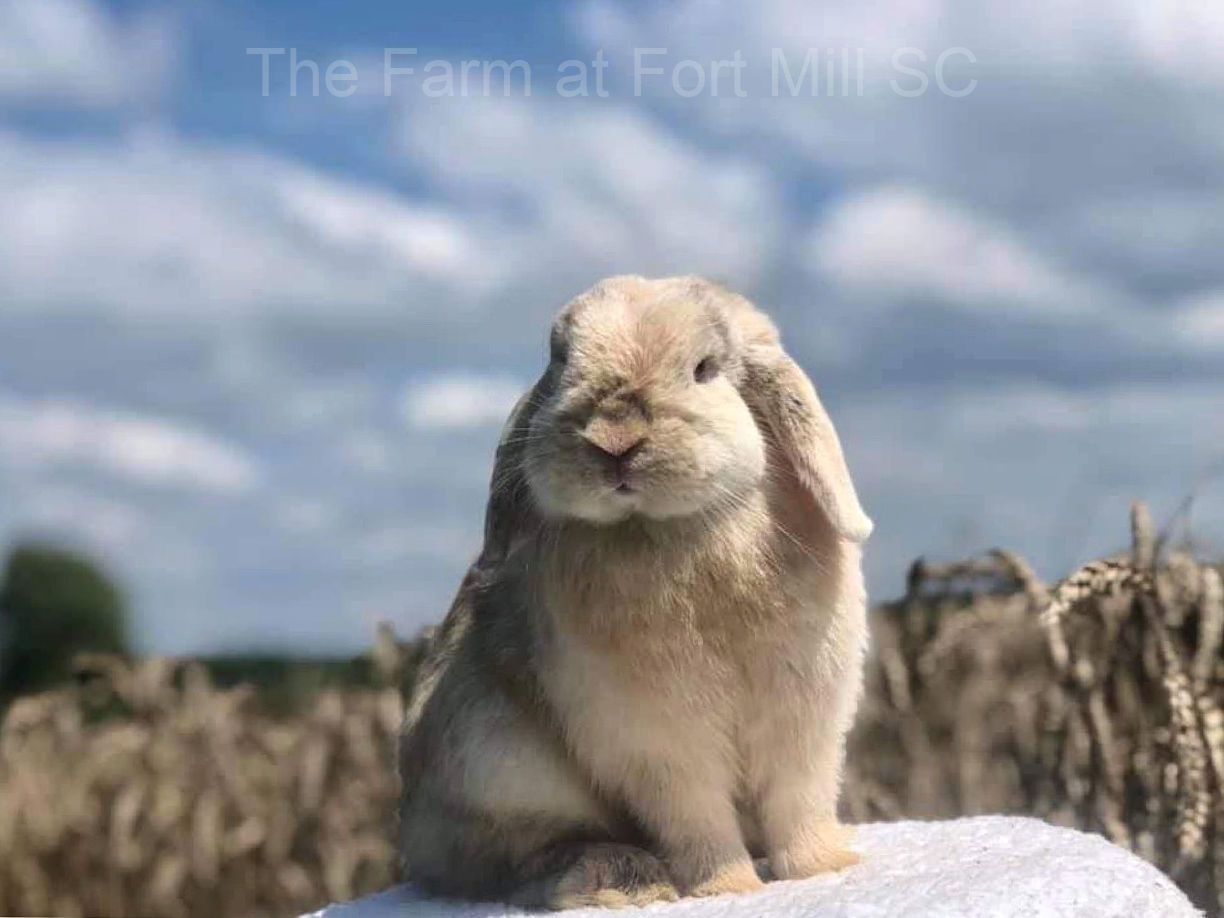Rabbit Health Care
for Non-Infectious Conditions
Non-infectious rabbit health care can be challenging for even the most experienced rabbit breeders. Here are a few tips and techniques that can help if you ever run into these problem.
These are the most common non-infectious
rabbit health care challenges:
Broken back, cannibalism, difficult birth (dystocia), hairballs, heat prostration, hutch burn, malocclusion, sore hocks, and red or milky white urine.
Broken Back:
Break or dislocation of the back caused by mishandling or the animal's startle reflex. What you see: complete paralysis of the hind end of the rabbit. It will just drag itself around the cage with the front legs.
If the back is just bruised, the rabbit may regain full use of his limbs within a few days to a few months. Get a vet's assessment of your rabbit.
Is your rabbit not moving? Check out stories and advice here. (Not all stories pertain to broken backs.)
Cannibalism:
The most common cause of cannibalism is from the doe getting a fright around the time that she gives birth. Strange people, noises or predators in the barn can stress the doe to the point of eating her kits.
Some rabbit lines or families are more nervous or high-strung than others. If a doe destroys a second consecutive litter, remove her from your breeding program.
Other reasons for cannibalism to consider in order to give the best rabbit health care:
- Abnormal maternal instincts. Does that scatter their kits and/or build a
poor nest tend to be more likely to also cannibalize their kits. If this is the
doe's first litter, give her a second chance, but just one second chance.
- A low-calorie or restricted feeding increases the
chance of cannibalism. If you palpate a
pregnant rabbit's abdomen around day 10 and you feel babies, slowly increase
the amount of feed until the doe has all the feed she needs.
Currently the best commercial rabbit food available in the USA:
Dystocia:
Dystocia implies a very difficult birth process possibly due to a birth canal that is too small. It is more common in breeds with large heads. Dystocia can also occur when the doe has
only a couple of very large kits in the womb. It is life threatening to
both doe and kits if the kits cannot pass through the birth canal. Rabbit health care requires immediate veterinarian
assistance.
Hairballs:
Rabbits are excellent groomers. As the rabbit grooms itself, it ingests hairs.
The minute you see rabbit poops strung together by fur like a black pearl necklace dangling from the rabbit's hind end or hanging off its wire cage floor, you'll know it's molting time. The ingested hairs usually pass through the intestinal tract uneventfully.
But sometimes they can clump together in the stomach and form hairballs that can block the exit from the stomach to the guts. When this happens, the rabbit can't eat, and will eventually die of starvation. Long-haired rabbit breeds are more susceptible to hairballs, also known as trichobezoars.
Treatment: Surgery to remove the hairball can be
performed, however the outcomes of surgery for a hairball blockage are known to be typically very poor. However you can also try
these rabbit health care remedies, which may or may not be effective depending
on the size of the hairball:
- A lubricant oil, such as mineral or olive oil
- Fruit juices or enzyme tablets containing bromelain, which is intended to digest the protein in the hairball. When the protein is digested, then the hairs can break away and pass through the intestines.
When you see those "black pearl strings," that is your clue to limit feed
for a day or two, and double up on fiber - grass hay or straw. Better to prevent the hairball than to lose the
rabbit.
Heat Prostration:
Rabbits can overheat easily, and die from too-high body temperature. Temperatures above 90 degrees F, especially over several days, can kill rabbits.
With heat, prevention is much better than discovering you have to emergency-cool 15 rabbits at once. For several effective ideas for keeping your rabbits cool, go to Cooling Rabbits.
Rapid respiration with open-mouth breathing is a very bad sign. If all other rabbit health care measures fail and the temps keep rising, then soaking the rabbit in a bucket of water (not the head) may save its life.
Warning: Heat stress can be cumulative.
Your rabbits may survive the heat on day one and day two, but then die on day
three. Redouble your efforts to keep
your rabbits cool as long as the heat wave continues.
Hutch Burn:
Hutch burn causes hair loss around the hind end due to contact with urine. Skin becomes reddened and tender, and the fur falls out in chunks where the urine has literally burned it away.
Rinsing the rabbit's hindquarters with lukewarm water (a couple inches in a sink) will help to sooth the rabbit's burned skin and stop the burning process. You can also apply a soothing balm to reddened skin.

We have only had one case of hutch burn. We followed these guidelines, and applied Emprizone (by Mannatech, Inc.) which is soothing and has healing properties.
(Emprizone® by Mannatech is amazing stuff. Antibiotic ointments do help to prevent infection, but do nothing toward actual healing per se. If anything, the oily base of the ointments may delay healing a bit. Emprizone has no downside that we are aware of. You may be amazed...!)
Click on picture to right, and then scroll down to Emprizone to learn more or to purchase.)
Emprizone is an excellent balm not only for rabbits, but also for rabbit scratches on rabbit breeders and for general household use, such as sunburns, cuts and scrapes. When our household tube runs low, we go into a bit of a panic till the next tube arrives. You never know when you'll need it, and you WANT it when you need it. Contact us if you'd like more information.
Best rabbit health care includes a thorough cleaning of the cage. Provide fresh bedding or a clean resting board. Keep a close watch on the rabbit to ensure that its environment stays clean. This should lead to complete relief.
Malocclusion:
Rabbit
teeth growing too long is usually (but not always) the result of a recessive
genetic trait. If the teeth are not trimmed, the rabbit may eventually not be
able to eat, triggering a rabbit health care crisis. The Rabbit
Teeth page has pictures and directions.
Obese Rabbits:
Obesity in rabbits can create severe health risks in both bucks and does impacting rabbit health care, including heart health, general health and the ability to reproduce. Some of those health risks can result in catastrophic outcomes. See Obese Rabbits.
Sore Hocks:
Sore hocks are open sores on bottoms of the back or front feet. First the fur wears thin, as a callus builds up, especially on the hind feet. If that callus should crack and bleed, they tend to get infected. This is called sore hocks.
Get the full scoop on sore hocks and rabbit feet calluses here.
Urine: Red Urine, Milky White Urine
Red Urine: This is a normal condition. The cause for the red coloration is not known, however some researchers suggest it is possibly part of a male dominance display, or the result of pigments in the feed sources.
Alkalinity enhances the coloration of the urine. According to Rabbit Production (Cheeke et al.), "This seems to be a normal phenomenon in the rabbit and does not indicate a disease problem" (pg 247). At any rate, no cause for alarm.
White Urine: Also urine-related is the tendency of rabbit urine to be milky white and to leave white deposits on the ground, the sides of the rabbitry or inside the rabbit cage. Rabbits absorb calcium from their feeds very efficiently. What is not needed is then excreted through the urine. If your rabbit has thick yellowish to whitish urine, you're seeing calcium suspended in the urine. This is the result of normal kidney function.
As we are not veterinarians, we direct you to the disclaimers
at the bottom of our Rabbit Diseases page.
Merck Veterinary Manual has some good rabbit health information
Double-Value Guarantee
Our policy is to always OVER-deliver
on value,
which is why your purchase is fully covered by our
Double-Value
Guarantee.
Go ahead - take any of our e-books for a test drive. Peruse our detailed informational and educational e-books. Examine our plans for building rabbit cages, runs, or metal or PVC hutch frames. Check out the Rabbit Husbandry info e-books.
If you aren't completely satisfied that your e-book purchase is worth at least double, triple or even quadruple the price you paid, just drop us a note within 45 days, and we'll refund you the entire cost. That's our Double-Value Guarantee.
Note: When you purchase your
e-books, they will be in PDF format, so you can download them to any device that
supports PDF format. We advise making a back-up copy to a drive or cloud
account. If the books are lost, you can also purchase another copy from Raising-Rabbits.











New! Comments
Have your say about what you just read! Leave me a comment in the box below.